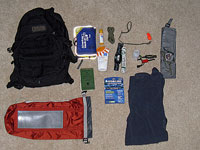 The “Ten Essentials” is a list of emergency items that is supposed to support you through an unexpected overnight stay in the backcountry and has been around for nearly 80 years. I was first exposed to the ten essentials as a Paratrooper in the Army, where the typical mission was 36 to 72 hours long and the only supplies we had was what we could stuff into small “butt packs,†or hip packs as they are known in the civilian world.
The “Ten Essentials” is a list of emergency items that is supposed to support you through an unexpected overnight stay in the backcountry and has been around for nearly 80 years. I was first exposed to the ten essentials as a Paratrooper in the Army, where the typical mission was 36 to 72 hours long and the only supplies we had was what we could stuff into small “butt packs,†or hip packs as they are known in the civilian world.
Paratrooper standard load (late 80’s to early 90’s)
- 4 quarts of water
- 1 MRE (around 1,300 calories)
- Waterproof poncho (for ground cover or shelter)
- Insulation top layer (wool or polypropylene)
- Flashlight and often a chemical light (glow stick)
- Map, compass, and protractor
- Knife (usually a multitool)
- 1 pair of extra socks and foot powder
- Orange signal panel
There are a lot of similarities between what we carried, back then, and the original Ten Essentials list:
- Map
- Compass
- Sunglasses and sunscreen
- Extra clothing
- Headlamp or flashlight
- First aid supplies
- Firestarter
- Matches
- Knife
- Extra food
You will find numerous variations on the Ten Essentials, but the themes are the same; hydration and nourishment, warmth, navigation, and signaling. It is important to note that the Ten Essentials is not something reserved for multi-day backpacking or mountaineering. These items are small enough and light enough that they can be carried anytime you venture into the backcountry, even if it’s for a short hike.
My carrier-of-choice is a CamelBak® hydration pack that holds just under a gallon of water and provides plenty of room for my essential items, along with anything else the kids and I might need on a hike, like lunch! Here are some of the “essential” items that I always carry with me, in my hydration pack.
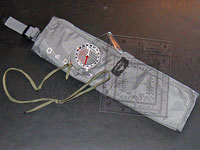
Map, compass and protractor
There is really no excuse for not having a topo map with you, since you can download them for free from the US Forest Service (see How to Find Topo Maps). I find a map and compass to be infinitely for useful than a GPS receiver, for navigation, although GPS certainly has its place as a valuable tool – just not on my list of “essentials.”
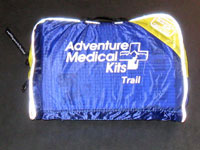
First aid kit
AMKs Trail model has just about everything a parent needs to handle backcountry emergencies, except for an ACE bandage. It’s about the size of a thick paperback book and, ironically, it contains an excellent book inside, called The Comprehensive Guide to Wilderness & Travel Medicine.
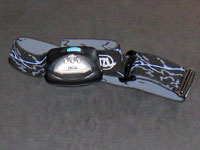
Headlamp
I’m part of the flashlight generation, but the first time I tried a headlamp it was all over and I’ve never gone back to the flashlight again. The Petzl ® TIKKA® is a little less than $30 and has three LEDs that provide plenty of light, while leaving both hands free.
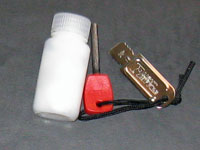
Fire starting kit
I carry a small magnesium fire starter and a bottle of cotton balls smeared with petroleum jelly, for starting fires in emergencies. The cotton balls burn long enough, and hot enough, to light even damp kindling. For more information, see How to Start a Fire with Magnesium, Cotton and Petroleum Jelly.
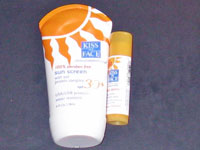
Sunscreen
This is mostly for the kids, although lathering them up with sunscreen often reminds me to use some too, which is probably a lot better for me than the numerous sunburns I’ve endured over the years. The Kiss My Face® sunscreen holds up well to perspiration and water.
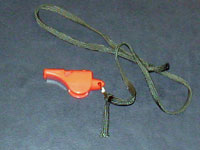
Emergency whistle
If you are ever in the position of having to direct a rescue team to your position, you will be able to truly appreciate how much further the sound from a whistle travels, than your voice (no matter how loud you try to shout).
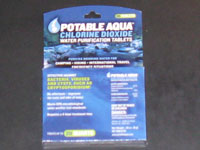
Water purification tablets
A gallon of water can only go so far, if you are stuck in the backcountry overnight. I don’t pack the entire box, but I tuck six tablets into the first aid kit, which is enough to refill my hydration pack twice.
See also…

Mark – I saw them at REI and was going to follow up on their website, but I got sidetracked. If I remember correctly, the Heatsheets looked perfect – maybe a little big, but that’s the sacrifice you make for something a bit more durable. I need to check into it again – I’m still on the fence and winter will be here soon!
Have you checked into Adventure Medical Kits Heatsheets Blanket or Emergency Bivvy? No grommets but light and compact and infinitely better than the old-fashioned silver mylar space blankets.
hiker – agreed, and the LED’s are a lot tougher than incandescent bulbs, too.
When considering what flashlight to take on a trip, try to stay with LEDs. The battery life with an LED flashlight is a lot longer then with a standard flashlight. And some LEDs come with a built in strobe light.
A Riverrock brand name, single AA battery, LED flashlight I have has a 3 position switch – off – solid beam – strobe light. The strobe feature extends the life of the battery and works well as a signal device.
Thanks Chris – I think I had one of the Coghlans years ago, but I couldn’t remember the brand name.
Roy – Coghlan’s also makes an emergency blanket that is similar to the All Weather blanket with grommets and works great just like Deb mentioned. I’ve used them for everything from tarps, ground clothes, wind blockers, and heat reflectors – just haven’t needed it in a real emergency situation yet!
We carry them in our eBay store here http://budurl.com/coghlansblanket if interested in checking them out.
Chris @ TheGearHouse’s last blog post..Relaxing Gear For Summer Trips To Take With You
Pingback: Great links from the hiking blogosphere
Tennessee Lights – that’s the best way to do it, just make it a regular thing.
Deb – thanks for the link, I think that is exactly what I’m looking for.
P.S. I don’t know if it’s okay to post a link here, but I wrote an article about the ten essentials and, if you scroll down a bit, I show that All Weather blanket I’m talking about. It’s at The Ten Essentials For Backcountry Travel. If you don’t want the link in your guestbook, I’ll understand if you delete this comment.
Being in Search & Rescue, I’m all about preparedness, so it’s great when I find people writing about it. It’s just that so many of our SAR missions would never have happened in the first place if the people we went to look for and/or rescue had had just some simple items in a small daypack. No navigational instruments (especially a map), no illumination, no hydration, no insulation, etc. Gear can’t take the place of common sense or skill of course–and sometimes plain ol’ bad luck sets in–but it sure does help avoid bad situations sometimes or at least enable someone to stick it out if they DO get into a pickle. Anyhow, nice post.
Oh! Space blanket. Have you looked at the All Weather blanket? It’s great because it has grommets at all four corners, so it can double as a tarp if you have some nylon cord, and it also can serve as a ground sheet. That’s what I carry, both in my SAR pack and my personal 24-hour pack.
I never leave home without a knife and flashlight in my pocket anyway. So I always have 20% of the essentials with me no matter where I am at or what I am doing.
Looking forward to your findings about the space/survival blanket. I’m definitely open to something better than the cheapie I carry.
John Soares’s last blog post..July Hike of the Month: Seven Lakes Basin in the Trinity Divide Mountains
Pingback: Camping Dad Shares Paratrooper 10 Essentials | BoyandGirlScouts.com - News, Opinion, Advice
John – I forgot to mention that I’m still searching for the right kind of space blanket/survival blanket. I don’t think the traditional “foil” kind will work well enough for an adult and a child. I looked at a bivy-style one that is interesting, but it seemed a little big.
Excellent list Roy. The Mountaineers Books has its own list that is my two hiking guides, and it’s essentially your “original” Ten Essentials, the second list from the top.
I always have a space blanket in my daypack. If I have to spend an unexpected night outside, it will at least keep the wind and precipitation off me.
John Soares’s last blog post..July Hike of the Month: Seven Lakes Basin in the Trinity Divide Mountains